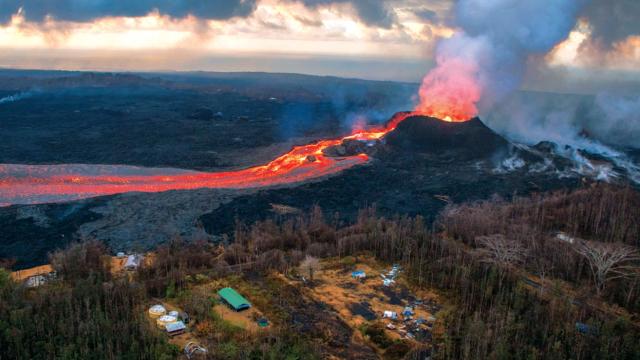Scientists are attributing the 2018 Kilauea eruption, which destroyed hundreds of homes on Hawaii’s Big Island, to a surprising source: intense and sustained rainfall.
Excessive precipitation in the months leading up to the eruption led to the collapse of rocky support structures near the caldera’s magma chamber, causing lava to creep up and burst through the surface, according to new research published on April 22 in Nature.
The study, co-authored by geologist Jamie Farquharson from the University of Miami, proposes a new way of predicting the timing and frequency of volcanic eruptions at Kilauea and other volcanoes. That said, excessive rainfall is one of many possible triggers leading up to an eruption, so this is no crystal ball.
[referenced url=” thumb=” title=” excerpt=”]
The 2018 lower Puna eruption began in early May. Giant cracks opened up along Kilauea’s lower East Rift Zone, pumping out alarming volumes of liquid rock. Local residents, threatened by toxic fumes and encroaching lava, had to flee their homes. By the time it was all over some four months later, hundreds of structures were left destroyed and the Hawaiian shoreline was remade.
That rainfall can influence both seismic activity and volcanoes is something scientists had considered, but these effects were only known to influence areas near the surface. The new paper is important because it suggests rainfall can perturb structures deeper below.
“We knew that changes in the water content in the Earth’s subsurface can trigger earthquakes and landslides. Now we know that it can also trigger volcanic eruptions,” explained Falk Amelung, a co-author of the study and a geophysicist at the University of Miami, in a press release. “Under pressure from magma, wet rock breaks easier than dry rock. It is as simple as that.”
The immediate cause of the 2018 Kilauea eruption was not known, prompting Farquharson and Amelung to investigate the potential for precipitation to be a contributor factor. Using both ground-based and satellite data, the authors chronicled what the paper describes as “anomalously high precipitation” in the months leading up to the eruption.
Much of this water trickled down through the volcano’s subsurface layer, owing to the porous volcanic rocks, according to the research. This had the effect of weakening rocks and increasing groundwater pressure deep below the surface, and in the areas surrounding the magma chamber. Using models fed by the acquired precipitation data, the authors showed that pressures near the chamber before the 2018 eruption were the highest in a half-century.
This fluid pressure served to weaken the volcano, causing structural failure at depth. Magma forced its way through the weakened rocks, rising upwards until it pierced the surface, according to this interpretation.
Interestingly, this theory also explains why there wasn’t significant uplift at the volcano in the months leading up to the eruption.
“An eruption happens when the pressure in the magma chamber is high enough to break the surrounding rock and the magma travels to the surface,” said Amelung. “This pressurisation causes inflation of the ground by tens of centimetres. As we did not see any significant inflation in the year prior to the eruption, we started to think about alternative explanations.”
The authors also conducted a historical analysis of Kilauea, looking at archived rainfall and eruption data going back to 1790. They found that nearly 60 per cent of eruptions occurred during the rainy season, which is shorter than the dry season.
Writing in an accompanying news and views article, planetary scientist Michael Manga from the University of California, Berkeley, said the new theory is plausible, but it needs to be taken with a grain of salt given the complexity and multifaceted nature of volcanic activity.
“The pressure changes computed by their models are small”smaller than stresses from tides,” he wrote. “However, if rocks are already close to breaking, such changes might be sufficient to initiate failure.”
As to whether fault failures can arise from changes to water pressure, that “remains uncertain,” said Manga. He continued:
“[The] first magma to erupt from the lower east rift zone in 2018 was old, perhaps left over from an earlier, 1955 eruption, implying that the rift zone was already hot. As a result, groundwater in the rift zone might have been vapour at shallow depths, and at greater depths it could have been a supercritical fluid (a substance that is not in a distinct liquid or gas phase, but has properties of both). The high compressibility of both vapors and supercritical fluids would dampen the magnitude of pressure changes in the authors’ model, making failure less probable.”
Manga believes the new theory can be tested by looking at other archival data to see if similar patterns emerge at other volcanoes. If confirmed”still a big “if” at this point”the new research could highlight an under-appreciated signal for forecasting the timing and frequency of volcanic eruptions.
This is a pertinent research question given the ways that climate change is already increasing the odds of heavy downpours in many locations. Fellow Hawaiian island Kauai, for example, set the U.S. daily rainfall record the month before Kilauea started erupting. It sounds bonkers, but global warming might contribute to increased volcanic activity”a possibility not lost on the researchers.
“It has been shown that the melting of ice caps in Iceland led to changes of volcanic productivity,” said Farquharson. “As ongoing climate change is predicted to bring about changes in rainfall patterns, we expect that this may similarly influence patterns of volcanic activity.”
